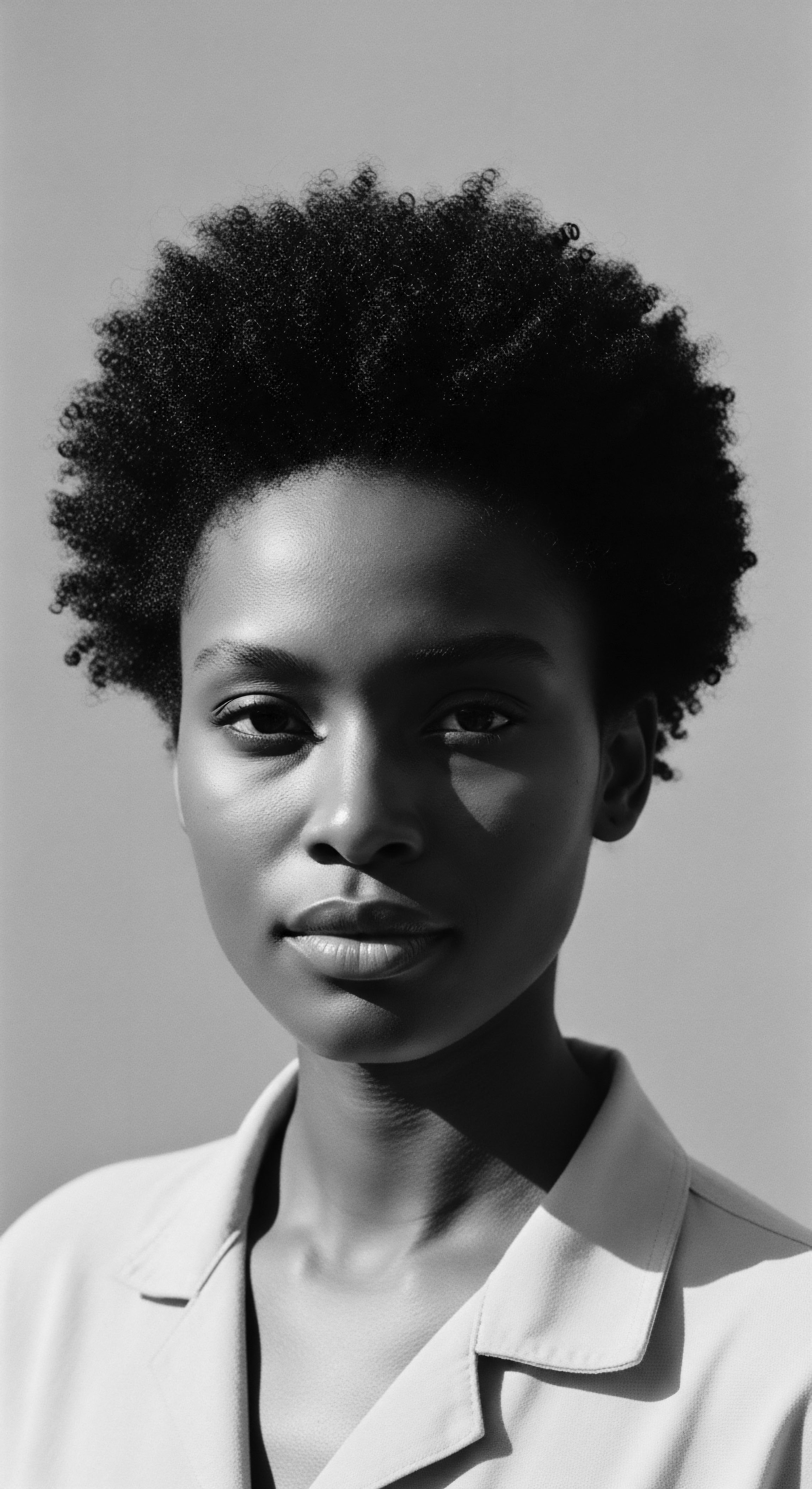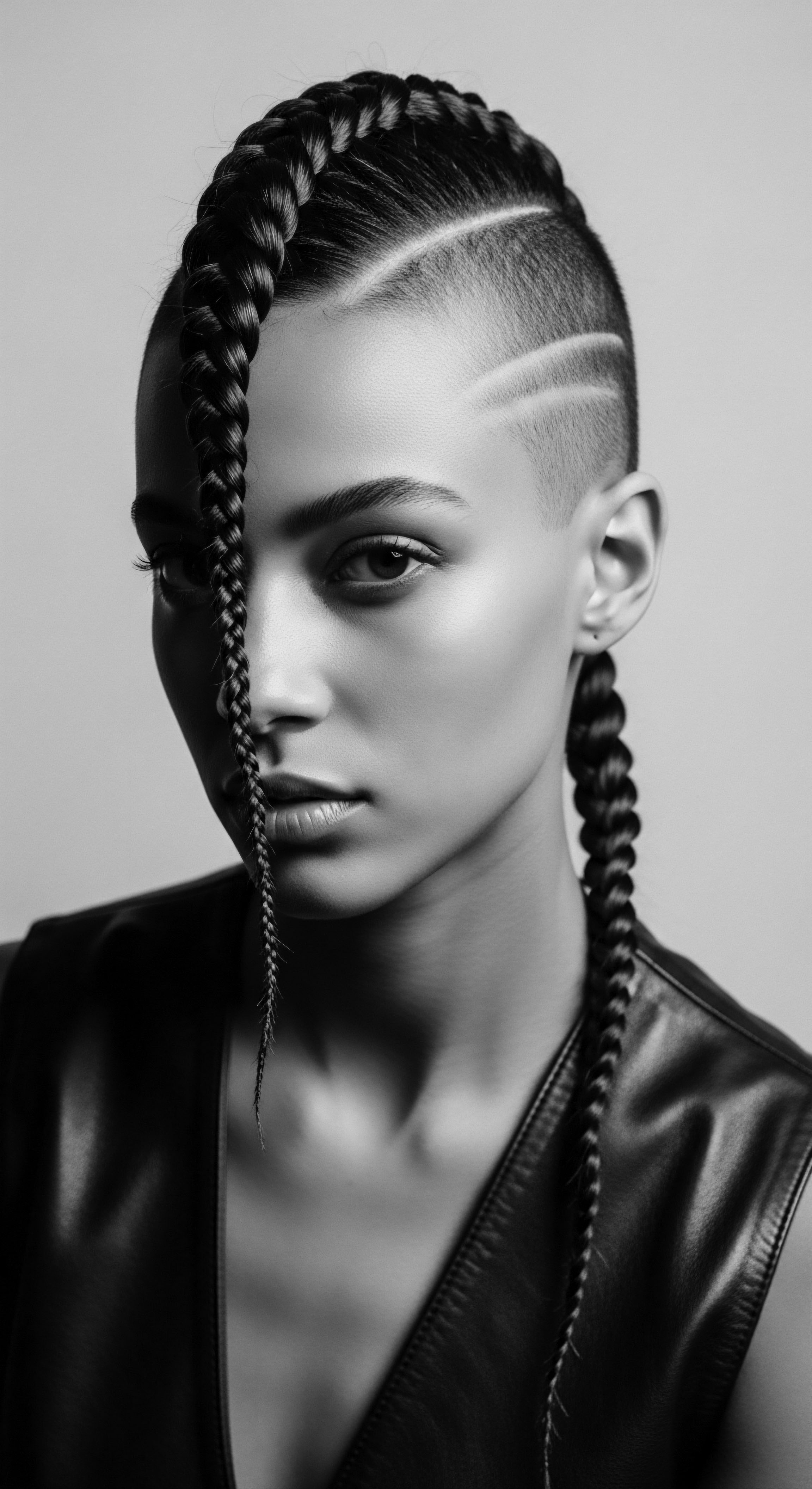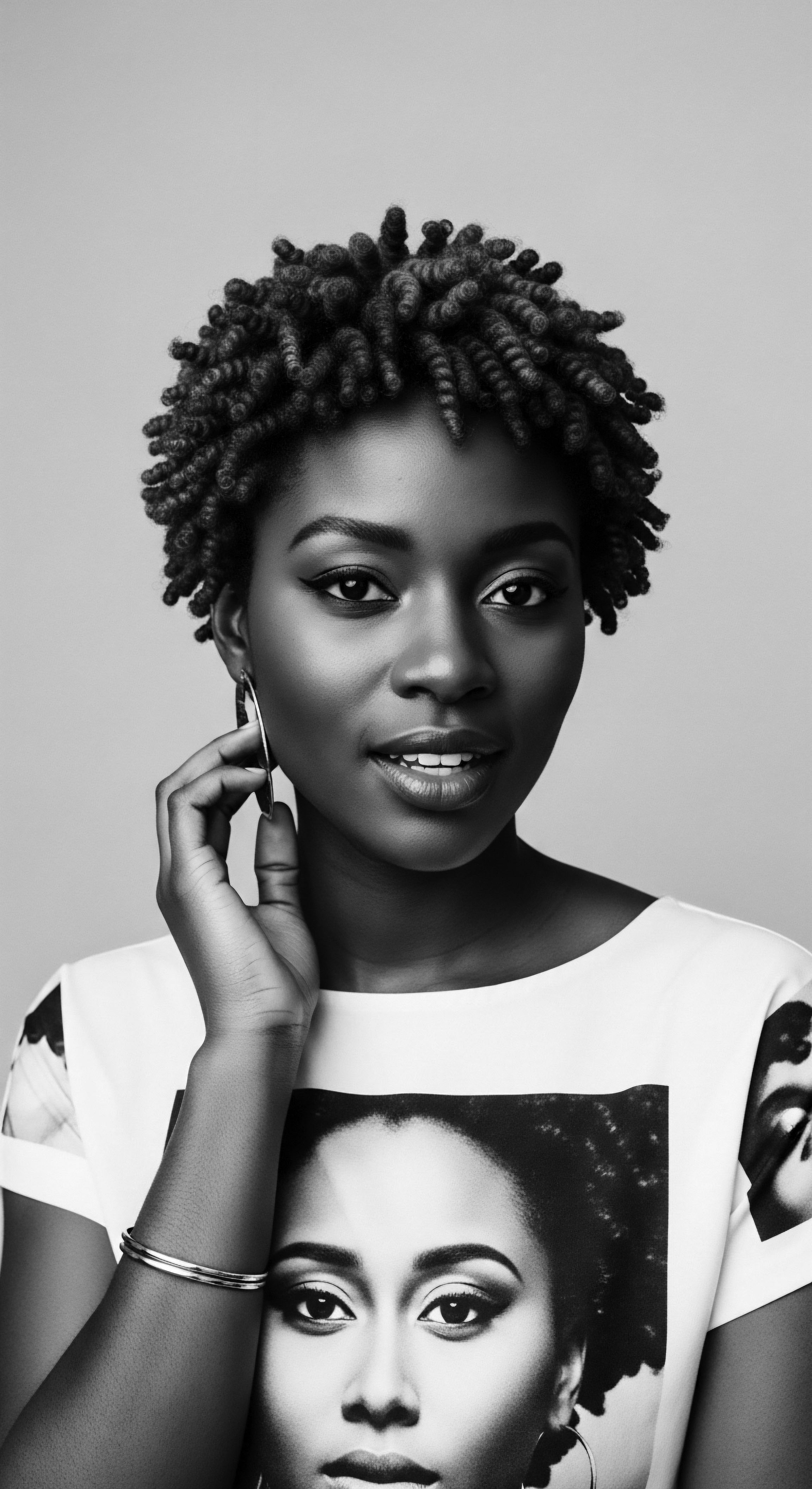
Roots
There is a whisper carried on the winds from ancient West African lands, a song of resilience woven into every strand of textured hair. It tells of cleansing rituals, of nourishing balms, and of a profound respect for the Earth’s bounty. For countless generations, before chemical concoctions and marketing campaigns, our ancestors knew the secrets hidden within native flora. They understood that the care of hair extended beyond mere aesthetics; it was a conversation with identity, a connection to lineage, a reflection of spiritual well-being.
The plants they gathered, prepared, and applied became silent partners in a sacred practice, a testament to inherited wisdom that continues to echo in our haircare today. These are not merely ingredients; they are living testaments to a deep, unbroken heritage, holding stories in their very fibers, waiting for us to listen.

Ancestral Understanding of Hair
From the intricate patterns of pre-colonial hairstyles that signified status, age, and spiritual connection, hair was always revered in West African societies. It was seen as the most elevated part of the body, a conduit for spiritual messages, even a symbol of prosperity and fertility. The physical anatomy of hair, with its unique coiling and varied porosity in textured strands, demanded specific care. Our forebears intuitively recognized these differences, developing practices that honored the hair’s natural inclinations rather than working against them.
Their approach was holistic, considering the overall health of the person, the community, and the environment from which these cleansing agents came. This ancestral knowledge formed the bedrock for understanding how different botanical elements could effectively clean without stripping, purify without damaging, and prepare the hair for adornment and growth.
The historical reverence for hair in West African cultures established cleansing as a foundational act, recognizing its role in identity and spiritual connection.

Earth’s Lather Traditional Cleansing Agents
The core of historical West African hair cleansing lies in plants rich in saponins, natural foaming compounds that gently lift impurities while maintaining the hair’s delicate moisture balance. These compounds, found in various plant parts, create a natural lather, making them ideal for traditional washing. The ingenuity of these ancestral methods becomes clear when examining the elemental biology.
Saponins reduce surface tension of water, allowing it to mix with oils and dirt, carrying them away during rinsing. This natural chemistry was understood and harnessed long before modern scientific terms existed, passed down through generations of practitioners who learned through observation and practice.
One primary example is African Black Soap, often known as Ose Dudu in Yoruba or Alata Samina in Twi. This remarkable cleanser originates from West Africa and is handcrafted from the ashes of locally harvested plant materials, such as plantain peels, cocoa pods, shea tree bark, and palm tree leaves. These ashes are then combined with water and various oils.
The resulting product is a powerhouse of natural cleansing agents, rich in vitamins A and E, and iron, offering gentle exfoliation and deep purification for the hair and scalp. The preparation of African Black Soap is often a communal activity, primarily led by women, embodying a lineage of shared knowledge and economic autonomy for many African women.
- Plantain Peels ❉ Offer vitamins A and E, along with antioxidants, supporting scalp renewal and protection.
- Cocoa Pods ❉ Contribute anti-inflammatory properties, providing a soothing sensation for irritated scalps.
- Shea Tree Bark ❉ Provides saponins for cleansing, alongside moisturizing qualities.
- Palm Tree Leaves ❉ Used in the ash mixture, adding to the soap’s cleansing and conditioning attributes.

What Role Did Moringa Play in Cleansing Rituals?
Moringa Oleifera, often called the “miracle tree,” is another plant with deep roots in West African health and wellness, extending to hair care. While more widely celebrated for its nutritional density and medicinal attributes, its seeds hold unique clarifying properties. The powdered seeds of Moringa have been traditionally used to purify water by flocculation, meaning they clump together impurities, allowing them to settle. This intrinsic ability to bind and remove particles suggests a natural cleansing capacity, making it a valuable, albeit less direct, cleansing agent for hair and scalp preparations.
Beyond its clarifying nature, Moringa oil, pressed from its seeds, has been employed for centuries as a conditioner, protecting hair from environmental stressors and nurturing the scalp, thus creating a healthy environment for growth. Its presence in traditional practices speaks to a comprehensive view of hair care that includes not just washing but also preparation and protection.

How Was Hibiscus Used for Hair Cleansing and Care?
Hibiscus Sabdariffa, or Roselle, a vibrant crimson flower, holds a place of honor in West African culture. While cherished in culinary traditions for beverages like bissap, its leaves and flowers have been historically integrated into beauty practices, including hair care. Rich in alpha hydroxy acids (AHAs), amino acids, and vitamin C, hibiscus provides a gentle exfoliating action for the scalp while strengthening hair strands.
Its mucilaginous properties create a natural slip, aiding in detangling and conditioning the hair, making it an ideal ingredient for a mild cleanser or a pre-wash treatment. The historical application of hibiscus in Ghanaian herbal steams and Nigerian hair treatments for strong, healthy growth underlines its dual role as a cleansing and nourishing agent, reflecting a thoughtful approach to maintaining hair integrity within communal beauty rituals.
| Plant or Product African Black Soap (Ose Dudu) |
| Traditional Application in Hair Cleansing Primary cleansing agent, used for washing hair and scalp, known for thorough, gentle purification. |
| Modern Scientific Understanding of Properties Contains high levels of natural saponins, vitamins A and E, and iron, providing surfactant action, exfoliation, and antioxidant benefits. Mohlakoana and Moteetee (2021) confirmed the presence of saponins in many traditional soap plants. Kunatsa and Katerere (2021) also discussed saponin-rich plants for cleansing. |
| Plant or Product Moringa Oleifera (Seeds/Oil) |
| Traditional Application in Hair Cleansing Water purification, scalp conditioning, and protective treatment; indirectly aids in removing impurities. |
| Modern Scientific Understanding of Properties Moringa seeds possess flocculant properties, binding to particulate matter for water clarification. The oil is rich in fatty acids and antioxidants, offering conditioning and environmental protection. Tsaknis et al. (1999) noted its use in hair care products. |
| Plant or Product Hibiscus Sabdariffa (Leaves/Flowers) |
| Traditional Application in Hair Cleansing Mild cleanser, detangler, scalp exfoliator, and growth stimulator in traditional treatments. |
| Modern Scientific Understanding of Properties Contains AHAs, amino acids, and vitamin C, which contribute to gentle exfoliation, hair strengthening, and antioxidant protection. These organic acids also provide a natural cleansing effect. |
| Plant or Product Piliostigma Thonningii (Leaves/Bark) |
| Traditional Application in Hair Cleansing Used as a soap substitute for washing hair and body due to its foaming properties. |
| Modern Scientific Understanding of Properties Known to contain saponins, which are natural surfactants capable of creating lather and cleaning. Mohlakoana and Moteetee (2021) list it among Southern African soap plants with saponin content. |
| Plant or Product These ancestral botanical selections illustrate a deep, intuitive knowledge of plant chemistry, applied to hair care with profound respect for heritage. |

Ritual
The application of cleansing plants in West African traditions transcends a simple wash. It is a carefully orchestrated ritual, a dialogue between the hands of the caregiver and the recipient, a moment steeped in communal meaning and generational continuity. These practices reflect an intermediate layer of understanding, where the elemental biology of the plants merges with the artistry of their application.
It is a dance of technique and intention, shaping not only the physical appearance of hair but also its cultural resonance, forming a vital part of textured hair heritage. These traditions were not static; they adapted, evolving with communities, yet their core purpose, rooted in ancestral care, remained steadfast.

How Do Cleansing Plants Shape Traditional Styling?
The preparation of hair for styling was as important as the style itself. Cleansing plants formed the initial step in these elaborate processes, creating a clean canvas. For generations, the effectiveness of African Black Soap ensured that scalp conditions were managed, allowing hair to grow strong and healthy, ready for braiding, twisting, or coiling. The texture of hair, with its unique curl patterns, benefits greatly from cleansing agents that do not strip natural oils.
This balance ensures the hair maintains its elasticity and definition, making it more pliable for intricate designs. Traditional styling often involved communal grooming sessions, strengthening familial bonds and transmitting knowledge. The act of cleansing together, often with naturally derived products, was part of this shared cultural legacy.
Hair cleansing was a communal ritual, deeply tied to family bonds and the transmission of traditional hair styling artistry.
Consider the significance of protective styles in West African heritage. Styles such as Cornrows, Braids, and Bantu Knots have historical origins deeply embedded in African communities, serving as both artistic expressions and practical solutions for hair management. Before these styles could be created, the hair and scalp required meticulous cleaning. The use of traditional cleansing plants provided the necessary purification without harshness, preparing the hair to be handled, stretched, and sculpted into these long-lasting forms.
The cleansing process thus laid the groundwork for hair health, which was foundational to the longevity and beauty of protective styles. This deep connection between cleansing and styling reveals a sophisticated understanding of hair care that prioritized both health and aesthetic tradition.

The Tools of Transformation How do They Relate to Cleansing?
Traditional West African hair care was a hands-on endeavor, relying on natural tools alongside plant-based cleansers. While brushes and combs were crafted from wood or bone, the hands of the practitioners were the most important instruments. The cleansing process often involved working the plant preparations through the hair with fingers, detangling strands, and massaging the scalp. This gentle yet thorough approach preserved the hair’s integrity, ensuring that its natural texture was not disrupted.
The synergy between the cleansing agents and the physical act of washing created an environment for healthy hair growth. Even today, many embrace these ancestral methods, preferring the tactile experience of natural cleansing and detangling over mechanical means, maintaining a direct connection to historical care rituals.
For instance, after a cleansing with African Black Soap, the hair, particularly textured hair, required careful detangling. Tools might include wide-toothed wooden combs or simply fingers, used in conjunction with conditioning agents like shea butter or oils to soften the strands. This post-cleansing routine was essential for preventing breakage and preparing the hair for subsequent styling.
This thoughtful progression, from cleansing with plant-based ingredients to detangling with gentle care, highlights the intentionality embedded in traditional West African hair rituals. These practices underscore a deep respect for the hair’s structure and an awareness of how best to maintain its strength and beauty over time.

Evolution of Cleansing from Ancestral Practices to Present
The journey of West African cleansing plants from ancient times to modern day is a testament to their enduring efficacy and cultural significance. While traditional methods remain in practice, there have been adaptations and transformations, particularly within diaspora communities. The core cleansing principles, however, persist. The historical forced shaving of heads during the transatlantic slave trade marked a violent attempt to strip identity and heritage, yet the resilience of Black people ensured that hair traditions, including cleansing practices, endured and evolved.
The continuity of these practices, even as they encountered new environments and challenges, showcases the adaptability of ancestral wisdom. Today, many commercial products draw inspiration from these historical plants, though sometimes losing the holistic community context of their origins. The table below illustrates this progression:
| Historical Context Pre-colonial West Africa |
| Traditional Cleansing Approach Handcrafted African Black Soap, plant infusions (e.g. Hibiscus), water mixed with powdered plant seeds (e.g. Moringa) for purification. Cleansing was part of communal grooming rituals, often signifying social status and spiritual connection. |
| Contemporary Relevance and Adaptation African Black Soap is widely available globally, often in modernized forms (liquid soaps, bars). Hibiscus and Moringa are recognized as beneficial ingredients in natural hair care products for their cleansing, strengthening, and conditioning properties. The communal aspect of care continues in various forms, including shared online spaces and natural hair meetups. |
| Historical Context Transatlantic Slave Trade and Diaspora |
| Traditional Cleansing Approach Forced stripping of traditional practices and hair, but clandestine preservation of knowledge. Resourcefulness led to using available natural materials for cleansing and care, adapting ancestral techniques to new environments. |
| Contemporary Relevance and Adaptation The legacy of resilience is seen in the modern natural hair movement, which reclaims and celebrates textured hair, often seeking out authentic ancestral cleansing and care methods. There is a renewed interest in ethnobotanical research for historical accuracy and effective product development. |
| Historical Context Modern Era |
| Traditional Cleansing Approach Increased commercialization of hair products. Challenges to preserve traditional methods against mass production, but also opportunities to introduce authentic, plant-based cleansers to a wider audience. |
| Contemporary Relevance and Adaptation Growing demand for natural, ethically sourced ingredients has led to a resurgence of traditional West African cleansing plants. Consumers prioritize transparent sourcing and ingredient lists, often seeking products that honor the origins and traditional preparation methods. |
| Historical Context The enduring use of these cleansing plants speaks to a heritage of adaptability and persistent care for textured hair, from ancient ritual to modern regimen. |

Relay
The continuum of West African cleansing plants in contemporary textured hair care represents a profound relay of ancestral wisdom, carried across generations and geographies. This is a complex interplay of elemental science, cultural resilience, and the deeply personal journey of identity. To understand their place today requires moving beyond surface descriptions, delving into their very composition, the scientific explanations behind their efficacy, and the social impact of their continued use. This exploration moves from the communal hearth to the molecular realm, anchoring modern understanding in timeless heritage, acknowledging that what was known by our ancestors holds significant weight in our present and future.

Phytochemistry of Traditional Cleansers Today
The effectiveness of historical West African cleansing plants, now used globally, is rooted in their rich phytochemistry. These plants contain specific compounds that interact with hair and scalp in beneficial ways. Saponins, natural glycosides found in many plants like African Black Soap’s components, are the primary agents responsible for their foaming and cleansing properties. They act as natural surfactants, reducing the surface tension of water and enabling the removal of dirt and oils without harsh stripping, which is particularly vital for maintaining the delicate moisture balance of textured hair.
Mohlakoana and Moteetee (2021) confirmed the presence of saponins in numerous Southern African soap plants, highlighting their cleansing qualities. Kunatsa and Katerere (2021) also documented 68 saponin-rich plant species from Africa, many used historically for washing and shampooing, further underscoring their scientific basis.
Beyond saponins, these plants boast a spectrum of other bioactive compounds. African Black Soap, derived from plantain skins and cocoa pods, offers Vitamins A and E, along with beneficial antioxidants. These elements contribute to scalp health, helping to combat issues like dandruff and irritation, which can compromise hair growth and integrity. Moringa, while not a direct lathering agent, offers a wealth of nutrients, including vitamins, minerals, and antioxidants, that support overall hair and scalp vitality.
Its seed extracts also demonstrate antibacterial activity and have been used in water purification, suggesting their clarifying effect on the hair and scalp micro-environment. Hibiscus, a plant used in Ghana and Nigeria for hair treatments, contains Alpha Hydroxy Acids (AHAs), amino acids, and vitamin C, contributing to gentle exfoliation of the scalp and strengthening of hair strands. These compounds work synergistically, offering comprehensive care that cleanses, nourishes, and protects.

How Do Cleansing Practices Influence Scalp Health?
The health of the scalp is paramount for vibrant textured hair. Historical West African cleansing practices inherently understood this connection. The gentle, plant-based formulations of traditional cleansers respect the scalp’s natural ecosystem. Harsh synthetic detergents can disrupt the scalp’s microbiome and strip away natural sebum, leading to dryness, irritation, and conditions such as seborrheic dermatitis.
In contrast, cleansers like African Black Soap, with their natural exfoliation and antibacterial properties, help to maintain a balanced scalp environment. The presence of anti-inflammatory compounds in ingredients like cocoa pods used in black soap, or specific constituents in Moringa, contribute to soothing the scalp, creating an optimal foundation for healthy hair growth. This understanding of scalp physiology, passed down through generations, finds validation in modern dermatological and trichological research, which increasingly recognizes the scalp as an extension of skin needing balanced, gentle care. The sustained use of these plants speaks to their effectiveness in fostering a scalp environment conducive to the unique needs of textured hair, minimizing common issues like dryness and breakage.

The Enduring Power of Plant-Based Cleansers in Diasporic Communities
The legacy of West African cleansing plants extends far beyond the continent, finding renewed prominence in diasporic communities worldwide. For individuals of Black and mixed-race heritage, reclaiming these ancestral practices is a powerful act of self-affirmation and cultural connection. This is not merely a trend; it is a movement rooted in historical memory and a desire for authentic, effective care. The challenges faced by textured hair in a world often dominated by Eurocentric beauty standards led many to seek alternatives to harsh chemical treatments.
The return to plant-based cleansers, passed down through family knowledge and now accessible through global markets, provides a tangible link to heritage. This reconnection offers both physical benefits, as these plants are often better suited for textured hair’s delicate structure, and profound emotional and spiritual nourishment, solidifying a sense of belonging and pride in one’s roots.
A striking example of this enduring power is seen in the continued widespread use and cultural significance of African Black Soap. Originating centuries ago, primarily in Ghana and Nigeria, its creation and application have been maintained by women, making it a symbol of empowerment and generational wisdom. The cultural preservation of its making and usage is not just about a cleansing product; it speaks to the resilience of practices that survived the Middle Passage and continue to serve as a beacon of natural care for Black communities globally. The demand for authentic, unprocessed African Black Soap speaks volumes about this connection, as consumers seek products that honor the integrity of their ancestral origins, moving beyond mere product consumption to a deeper engagement with their cultural patrimony.
The continued use of ancestral cleansing plants by diasporic communities marks a powerful reconnection to heritage and a deep affirmation of Black and mixed-race identity.
The global shift towards natural and organic products has created an environment where these historical cleansing plants can gain wider recognition. Yet, the narrative must remain centered on their original cultural context and the generations of women who preserved this knowledge. Ethnobotanical studies continue to validate the traditional uses of these plants, offering scientific explanations for what our ancestors understood intuitively. This interplay between ancient wisdom and modern research provides a comprehensive understanding of how these cleansing plants support the unique needs of textured hair, ensuring its health and celebrating its inherent beauty.
The movement for natural hair, a reclaiming of ancestral styles and care practices, often integrates these cleansing plants. This re-embrace is not simply about what is natural; it is about what is authentic, what is culturally affirming, and what offers holistic well-being. It represents a living archive of hair care, a testament to the fact that the oldest ways often hold the deepest truths.

Reflection
As we conclude this exploration, the echoes of West African cleansing plants reverberate beyond their botanical origins, settling into the very essence of textured hair heritage. These natural gifts, from the saponin-rich lather of African Black Soap to the scalp-nourishing touch of Moringa and the clarifying caress of Hibiscus, stand as living archives. They remind us that care, true care, is a lineage, a whispered instruction passed from elder to child, a practice rooted in respect for the earth and for self. The Soul of a Strand finds its truest voice when bathed in this ancestral wisdom, recognizing that each coil, kink, or wave carries the weight of history and the promise of a sovereign future.
Our hair, cleansed by these age-old botanical allies, becomes a testament to enduring strength, a canvas for identity, and a profound connection to the communities that have nurtured these traditions for centuries. The journey of these plants, from West African soil to global recognition, symbolizes the unbroken spirit of Black and mixed-race experiences, a gentle yet potent affirmation that the roots of our beauty run deep, unwavering, and eternally vibrant.

References
- Jackson, B. & Rodriguez, A. (2023). What Every Dermatologist Must Know About the History of Black Hair. Practical Dermatology.
- Mohlakoana, M. & Moteetee, A. (2021). Southern African Soap Plants and Screening of Selected Phytochemicals and Quantitative Analysis of Saponin Content. Resources, 10(10), 1-18.
- Kunatsa, Y. & Katerere, D. R. (2021). Checklist of African Soapy Saponin—Rich Plants for Possible Use in Communities’ Response to Global Pandemics. Plants, 10(5), 842.
- Tsaknis, J. et al. (1999). Moringa oleifera seed oil. Journal of the American Oil Chemists’ Society.
- Akinbiyi, F. et al. (2015). Indigenous uses and phytochemical contents of plants used in the treatment of menstrual disorders and after-childbirth problems. Journal of Drug Delivery & Therapeutics, 5(3), 33-42.
- Sharaibi, O. J. Oluwa, O. K. Omolokun, K. T. Ogbe, A. A. & Adebayo, O. A. (2024). Cosmetic Ethnobotany Used by Tribal Women in Epe Communities of Lagos State, Nigeria. Journal of Complementary Medicine & Alternative Healthcare, 12(4).
- Aguh, C. & Okoye, G. (2017). Fundamentals of Ethnic Hair ❉ The Dermatologist’s Perspective. Springer.
- Uchegbu, N. N. & Ogbuehi, E. C. (2022). Moringa Oleifera as a Gift of Nature to Human Beings. Journal of Scientific Research & Reports, 28(2).
- Ahmad, N. & Khan, I. (2021). Moringa oleifera is a Prominent Source of Nutrients with Potential Health Benefits. Journal of Medicinal Food.
- Byrd, A. D. & Tharps, L. L. (2014). Hair Story ❉ Untangling the Roots of Black Hair in America. St Martin’s Griffin.
- Asare, E. (2021). The Role of Hair in Ancient African Cultures.
- Okonkwo, E. P. et al. (2023). Antimicrobial, antioxidant activities, and total phenolic contents of Pycnanthus angolensis Sap and Cryptolepis sanguinolenta root extracts. Springer Medizin.
- Falade, M. D. & Adewusi, T. O. (2019). African Journal of Food Science – Moringa oleifera ❉ an underutilized tree in Nigeria with amazing versatility ❉ a review.
- Azeez, R. (2023). Women in Beauty Cultures and Aesthetic Rituals in Africa. Oxford Research Encyclopedia of African History.
- Akerele, O. (1993). Medicinal Plants and Traditional Medicine in Africa. OAU/STRC. (General background, not directly cited, but supports the overarching theme of traditional plant use in Africa).
